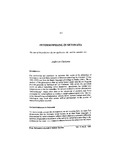| dc.contributor.author | Chebanne, A. | |
| dc.date.accessioned | 2011-06-28T13:26:22Z | |
| dc.date.available | 2011-06-28T13:26:22Z | |
| dc.date.issued | 1996 | |
| dc.identifier.citation | Chebanne, A. (1996) Intersuffixing in Setswana: the case of the perfective -ile, the applicative -ela, and the causative -isa, Pula: Botswana Journal of African Studies,Vol. 10 No. 2, pp. 83-94 | en_US |
| dc.identifier.issn | 0256-2316 | |
| dc.identifier.uri | http://hdl.handle.net/10311/863 | |
| dc.description.abstract | Our motivation and inspiration to undertake this aspect of the phonology of
Setswana is derived from research in Setswana phonology by Creissels (Notes,
1991-1992) and from the Bantu languages phonology by Bastin (1983). The reanalysis
of the phenomenon that we earlier treated under what the two linguists
describe generally as "imbrication"l (cf. Chebanne, 1993, ACAL 24), and which means an affixal imbedding which transforms morphemes has yielded new
mterpretations on the Setswana data. We are now inclined to call this phenomenon
"intersuffixing", which refers here to the adjustment of positions and forms undergone by verbal suffixes according to morpho-phonological rules. The two terms, intersuffixing and imbrication, actually do not mutually exclude each other.
Imbrication may result after certain suffixal permutations in the process of
intersuffixing have occurred. | en_US |
| dc.language.iso | en | en_US |
| dc.publisher | University of Botswana, Office of Research and Development, http://www.ub.bw | en_US |
| dc.subject | Inersuffixing | en_US |
| dc.subject | Setswana phonology | en_US |
| dc.subject | Setswana | en_US |
| dc.title | Intersuffixing in Setswana: the case of the perfective -ile, the applicative -ela, and the causative -isa | en_US |
| dc.type | Published Article | en_US |

